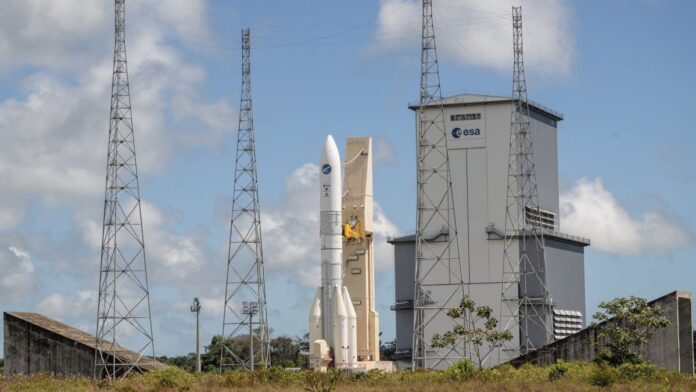The European Space Agency (ESA) shared a new view of the Ariane 6 rocket on its launch pad ahead of engine tests this month.
A new photo shared on June 23 shows ESA’s heavy-lift Ariane 6 rocket on the launch pad at Europe’s Spaceport in French Guiana. It is the first view of Ariane 6 standing vertically on its launch pad. The rocket has been in development since the early 2010s, and is intended to replace the Ariane 5 launch vehicle, providing customers lower-cost access to space.
This view of Ariane 6 shows it being prepared for a round of engine fire tests, with removal of the mobile building that protects the rocket while it sits on the launch pad. As part of this process, the doors of the mobile gantry are opened and the structure rolled back on rails, according to a statement from the space agency.
Related: Meet Ariane 6 and Vega C: Europe’s New ‘Rideshare’ Rockets (Videos)
“The operation, which takes about half an hour, was a trial run in preparation for a series test firings of the Vulcain 2.1 engine,” ESA officials said in the statement. “These test firings will be conducted on the launch pad as part of ongoing preparations for the first-ever flight of Ariane 6.”
The Ariane 6 rocket in the recent photos from ESA is being used solely to test assembly procedures, electrical and fuel connections and telemetry, and is not intended for flight. The procedure of removing the mobile gantry and returning it for the first time helps validate the rocket’s ground infrastructure.
The Ariane 6 rocket is being built in Europe by ArianeGroup on behalf of ESA. The core and upper stages of the rocket were shipped to French Guiana and assembled horizontally. The rocket was then moved to the launch pad, where the vehicle was lifted upright inside the gantry before attaching the solid-fuel boosters and payload. This is the first time an Ariane rocket has been assembled horizontally, which officials said cuts down on the time and cost of launch, according to the statement.
The debut flight of Ariane 6 was originally planned for 2020 but has slipped several times since. The latest target for launch is the second quarter of 2024, at the earliest. The rocket features a reignitable upper stage called Vinci that can deliver satellites to various orbits and altitudes. It is designed to deorbit autonomously and burn up in Earth’s atmosphere.


